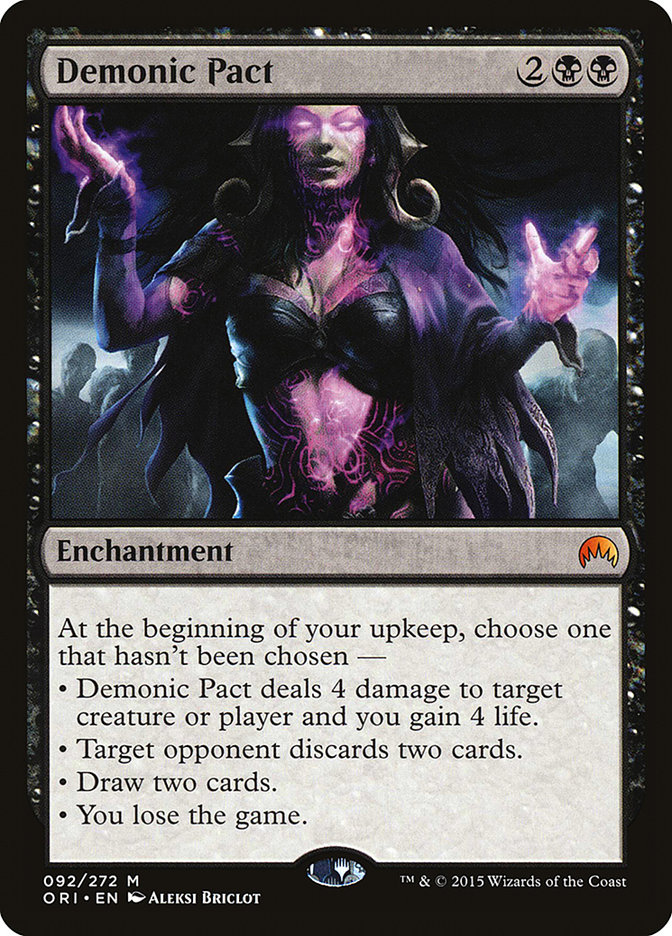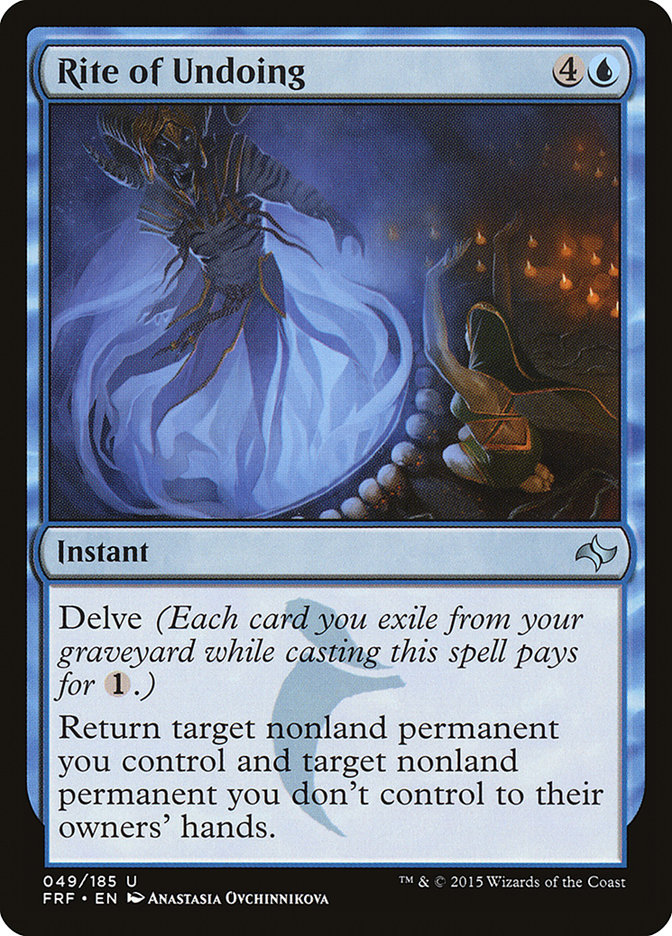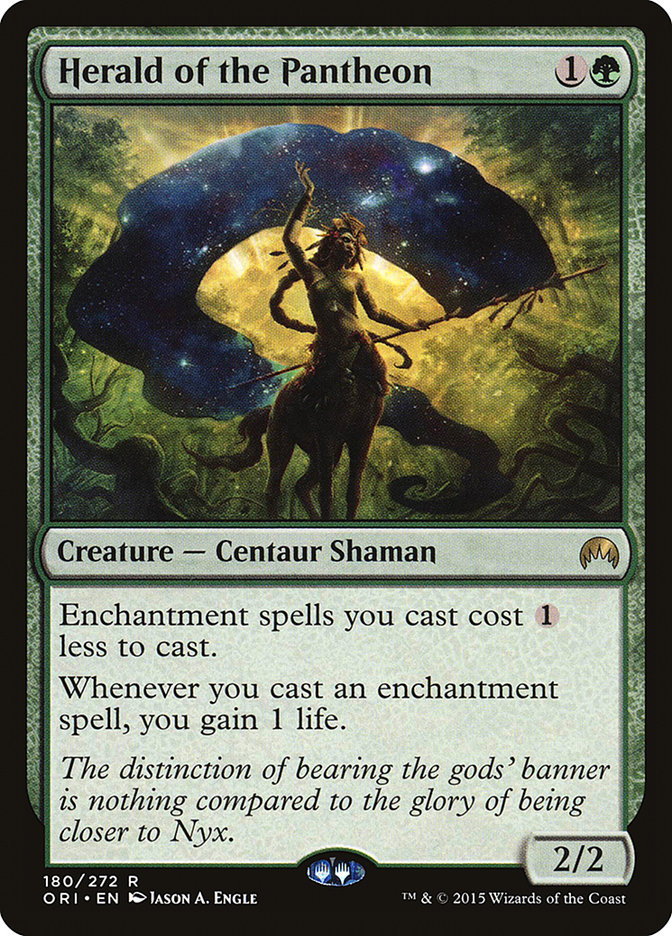Every new year brings a fresh start, the promise of exciting new opportunities, and the prospect of casting off the bad things that happened the year before while ruminating on the good. New Year’s Resolutions are a bit passe’ these days, but in our hearts, we all make promises to ourselves. This year will be better.
But what if you’ve made a commitment that you’re not keen on seeing to the end? Maybe you just wanted to get the better parts of the commitment without the responsibility, either proactively or subconsciously? You might have done everything you needed to, up to a point. Or, if you’re like a lot of us, there’s one last step that you just can’t seem to make.
Oh right. That one.
Demonic Pact, apart from being one of the most flavorful additions to Magic Origins, is a card that perfectly analogizes our innate human desire to get as much benefit as we can with as little responsibility or consequence as possible. Demonic Pact, on its own, will likely lose you the game before you win it. Thus, figuring out how to “get out” of the final clause of Demonic Pact is the name of the game when you feature this enchantment in your deck. Thus, this is a promise that’s begging to be broken.
Several successful Demonic Pact decks have been floating around since the spell first debuted, with a finals appearance in September at the SCG Open Series event in Milwaukee and, coincidentally, a top 75 finish in the same city’s Pro Tour a month later. The decks, which followed Sultai and Esper lines, provide a good starting point for Demonic Pact. After all, there are only so many spells that can actually help us evade our infernal promise.
Let’s hope the demons aren’t eavesdropping.
Disperse is fine, but it represents a certain safety that doesn’t seem fitting when working in the confines of a fiendish contract. If you’re going to break a deal with the devil, do it in style, guns blazing and certain fingers raised. The fact that Rite of Undoing can act as temporary removal for one of your opponent’s most problematic permanents while also reneging on your deal is right on point. Sultai is already a little hackneyed, with its straightforward enchantment removal and Den Protector. Instead, I’ll get around my earlygame woes with some solid red removal and a hard-to-answer sideboard plan.
Creatures (8)
Lands (26)
Spells (25)

Creatures
Demonic Pact is all about the enchantment, not about the creatures that inevitably get you there. Hangarback Walker is one of the best Grixis cards in the format; with only the cripplingly expensive Jace, Vryn’s Prodigy as an alternative, the two-drop creature slot is pretty barren for this color combination, especially in a control build. Hangarback Walker does its job, but it also provides you tokens to bounce with Rites of Undoing if you need a target of your own. It also works well with our singleton Kolaghan, the Storm’s Fury, which is a nice, independent win condition if you’re facing down sorcery removal. Pumping an armada of Thopters is probably this card’s best line, but alone, Kolaghan does good work. Finally, Carrier Thrall might seem unusual, but it’s a way to slow down aggressive decks while giving myself a burst of mana. It’s a bit like Viridian Emissary in that way, if you remember that card, giving you a turn 3 Demonic Pact if they take the bait.
Spells
Except for the Demonic Pact, the balance of our nonland cards is comprised of instants and sorceries. Duress is perhaps the biggest bane of this deck; having the method by which you remove Demonic Pact get countered is not only hilarious, but it’s literally game over. Duress has been gaining more ground for me as a maindeck replacement for Thoughtseize in control decks, not only for its low cost, but that it almost always has a target. Against ramp decks, it can hit a ramp spell or Ugin, it can hit Rally the Ancestors, Atarka’s Command, or Dig Through Time, too. Especially if cast early, it’s likely going to hit something. It is a net-zero spell when considering a delve spell for the turn. Also, if you happen to bounce an enchantment or other hard-to-remove noncreature permanent, you can pluck it out of their hand. Despise has the same premise, and it still hits those pesky planeswalkers.
Disperse is here, but more as a way to answer early problems, such as pumped or prowess-oriented attackers or as a soft counter. It can target a Demonic Pact when the demon is knocking at your door, of course. Murderous Cut, Radiant Flames, and Kolaghan’s Command are all efficient ways to deal with everything else. Painful Truths, which has gained a lot of ground lately and whose life cost is mitigated by Demonic Pact’s lifegain, is easily leveraged with inexpensive, delve-oriented spells, meaning you can often draw cards and cast a spell that turn, even in the first few turns.
Sideboard
Thunderbreak Regent is an excellent playset out of the sideboard. After seeing little in the way of creatures in the first game, bringing in evasive, four-power creatures that hurt them for getting targeted seems like a great option. Moreover, with Rite of Undoing, you can respond to their few remaining removal spells by returning it to your hand while bouncing their permanent. Spicy! Negate and Silumgar’s Command work to counter control decks, but Silumgar’s Command has the added benefit of being able to bounce the Pact; this is not new, as it’s seen the same place in other Pact decks. Infinite Obliteration helps us deal with problem value creatures like Siege Rhino, Den Protector, or the inevitability of cards like Ulamog, the Ceaseless Hunger. More Radiant Flames protect us from Atarka Red, token, and landfall decks.
Finally, I have to include the single Shifting Loyalties. Oh yeah, you know you want to draw it against an enchantment deck or even another Demonic Pact deck. “Sure, I’ll take your freshly cast Demonic Pact. Yeah, I’ve got three counters on mine. Enjoy your upkeep.” If you have ever done this, please tell us in the comments so we can all give you a cyber high-five.
Admittedly, this seems a bit forced. Red isn’t as prominent as I’d like it to be, mostly because it can’t interact with the Pact, either by removing, recovering, or finding it.
But remember how Demonic Pact can’t really work by itself? Well, maybe it kind of can.
A contemporary mythic to Demonic Pact, Starfield of Nyx acknowledged the theme of Theros, the set that was to enchantments what Mirrodin was to artifacts and what Scars of Mirrodin was to boredom. #SlingShady. The Starfield saw a bit of sideboard play when Theros was still legal, but it has since fallen off the theme park map as people have left to visit FourColor’s Goodstuffland®. Now, though, it provides an intriguing synergy. When you have enough enchantments, Starfield of Nyx makes Demonic Pact a creature with power and toughness equal to its own cost, a 4/4 in this case. Demonic Pact can lifelink lance a creature or player for four damage. Thus, at your option, you can use the draw and discard options, opting to destroy the Pact with the Pact. And don’t worry! The Starfield will return your Pact to the battlefield the following turn, allowing you to constantly stay stocked on cards while depriving your opponent of any. Gain four life, recover, and continue, all without doing anything else.
Starfield of Nyx is designed to be a win condition, but I’ll see that win condition with the Pact and see how deep we can take it.
Fresh from the ranks of last week’s deck, the Herald gives us an opportunity to get either piece online faster while gaining all the life I’d need to use fetchlands or painlands with abandon. The incremental lifegain is essential to staying afloat against the aggressive decks, and the cost reduction lets us jam as many enchantments per turn as we can.
This leaves us in Abzan, but no Siege Rhinos this time!
Creatures (7)
Lands (25)
Spells (28)

Creatures
As before, the creatures are a means to an end, but they each play an important role.
Herald of the Pantheon is the king of this deck; an on-curve green spell with relevant mid- and lategame potential is all I could ask for. Combined with this reduction, you can stay on-curve with cheap enchantments. Turn 2 Silkwrap, turn 3 Herald into Silkwrap. Safe! Herald makes lots of different plays possible, and it looks good doing it. Rattleclaw Mystic…that’s one ugly Elvish Mystic. Still, I’ll take redundancy this time. Finally, there’s a single Void Winnower and Ulamog, the Ceaseless Hunger, which handles Demonic Pact if nothing else can manage to. The Winnower might seem strange, but the single strongest answer my opponent can cast to my enchantment nonsense is Ugin, the Spirit Dragon. With one fell swoop, Ugin clears out my exile-based removal, my win conditions, and everything I hold dear in this world. Thus, Void Winnower, which can be tutored with the deck’s three copies of From Beyond, makes sure my opponent just can’t even.
Spells and Enchantments
Unlike the Grixis list, the only nonenchantment spell in this deck is a set of Murderous Cut. While Murderous Cut has its conventions, it can also kill an animated Demonic Pact if you find you need to throw its four damage ability elsewhere.
Starfield of Nyx is a greedy card. It needs lots of enchantments to stay online, so to reach that critical five-enchantment mark, we have to figure out ways to play and build up low-cost enchantments. The most promising way to do this is through removal. Silkwrap, Stasis Snare, and Quarantine Field all serve a similar purpose and, in the case of turning the Starfield online, they can all be cast without targets if needed. Quarantine Field is a solid way to handle Demonic Pact, and it can often grab a couple other problem cards at the same time, especially if Herald is reducing the cost.
Now, making all the double white and double black mana might seem difficult in a deck that needs early green action, and you’d be right. Lucky for us, we have Shattered Aerie. While no Verdant Haven or Market Festival, it does have a unique ability to produce two colored mana that need not be the same as the mana produced by its host. A Forest can produce WW, UU, BB, RR, or GG with a Shattered Aerie, and the price is right, too. Consider this line. Turn 2 you play a Herald of the Pantheon. Turn 3 you play a land, casting the Shattered Aerie targeting the new land. This gives you two mana of any color, which you can then use to cast Stasis Snare or two Silkwraps! Nice!
Out of 23 enchantments, five are singletons. As with the deck from last week, From Beyond can easily be cast on turn 3 with either two-mana creature helping, and it can produce endless blockers or mana producers while you get the enchantment team online. As a sidenote, once you sacrifice From Beyond to search for an Eldrazi, you get it back if Starfield is on the battlefield! Evolutionary Leap can be used to eat an Eldrazi Scion or an animated enchantment. Maybe that 1/1 Hangarback Walker you ate on turn 2 isn’t so good, so you sacrifice it to find another creature, only to bring it back from the graveyard the following turn to pin something else down. It is also a tidy way to eat your own Pact. Then there are three Sieges, each with relevant modes that, if they die, can be changed upon resurrection. You get the idea.
The lands and sideboard speak for themselves, for the most part; I like Hedonist’s Trove as a spicy way to deal with Rally the Ancestors besides just Negate. I just want to try it.
You’ve escaped the jaws of the abyss. How do you do it? What’s your favorite way to use Demonic Pact? Besides the Pact, what cards are you excited to see shine in the new year?




